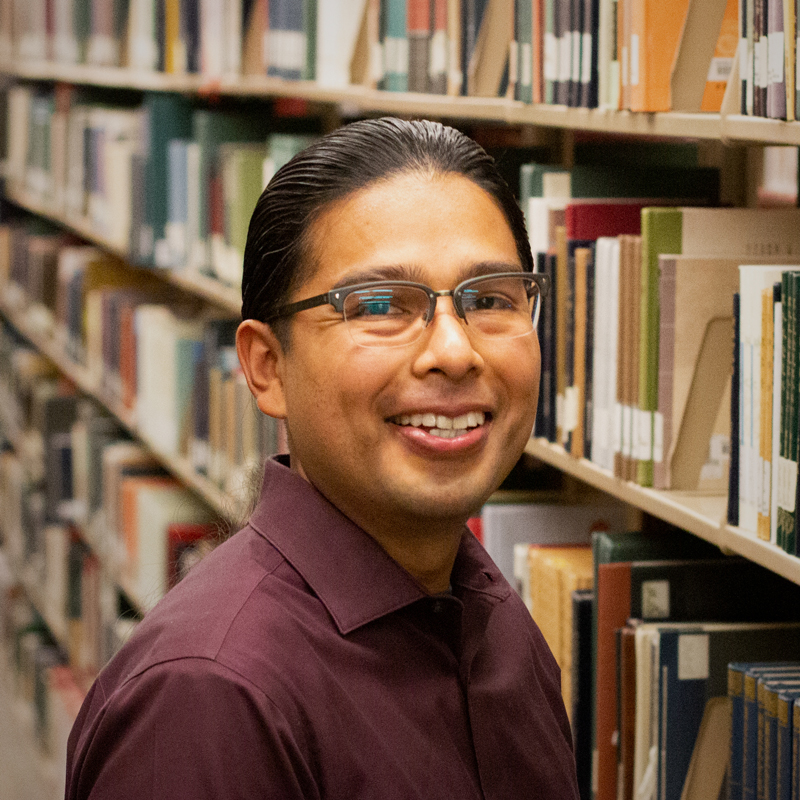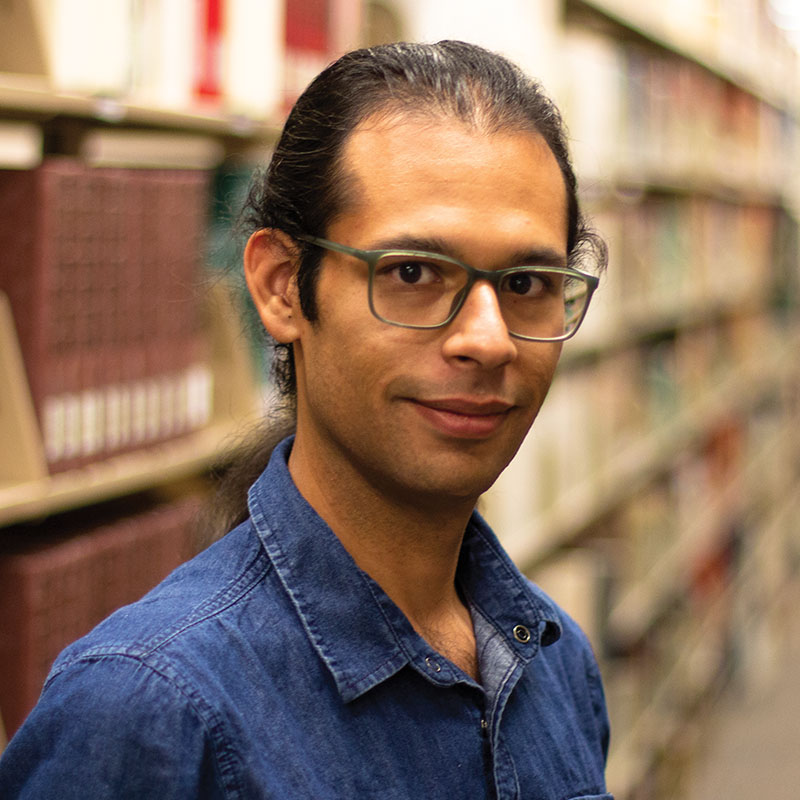Editor's note: Arizona State University has previously acknowledged the ancestral homelands that the Tempe campus sits on and will continue to do so as the ASU community continues this important conversation. Please find the university's statement on its commitment to Native nations, posted in August 2015, here.
“The ASU Library acknowledges the 22 Native Nations that have inhabited this land for centuries.”
Thus begins the Arizona State University Library’s first Indigenous land acknowledgement – a five-sentence, 116-word statement about the place that the library and the university have inhabited for more than a century.
“The statement represents the ASU Library’s intentions to begin a healing process,” said Lorrie McAllister, associate university librarian for collections and strategy. “We need to acknowledge that ASU is an occupant on Indigenous lands and that we need to take active steps to forge relationships of reciprocity.”
Alex Soto (Tohono O’odham) and Brave Heart Sanchez (Ndeh and Yaqui), both graduate students in the University of Arizona’s Knowledge River Program, add that the statement also represents a crucial first step toward welcoming Indigenous peoples into the library, recognizing their knowledge systems and their relationships to their land, while opening the door to further opportunities for engagement.
Alex Soto
“Land acknowledgement is only the first step,” said Soto, who, together with McAllister and Sanchez, currently leads the ASU Library’s Labriola National American Indian Data Center, which encompasses dedicated Native community space within the library and a notable collection of rare books and manuscripts, as well as open stack circulating materials that are by, for and about Native Americans — a library within a library.
Under the direction of McAllister, the statement was crafted by Soto and Sanchez, with input from Jacob Moore, associate vice president of tribal relations at ASU; Joyce Martin, associate librarian and head of the library’s social sciences division who led the Labriola Center for more than 12 years; and other key faculty and staff stakeholders.
Soto, an operations supervisor who manages the Labriola Center on the West campus, says the land statement does a good job of recognizing where we are as a university library, both figuratively and literally, and can serve as a launch pad for deeper conversations about how the ASU Library might integrate and prioritize Indigenous knowledge systems.
“We are on Akimel O’odham land, and that always needs to be at the forefront of our thinking,” he said. “This is the nation whose land we are on, and they’re still here. Today, the Akimel O’odham and Pee Posh reside in the Salt River Pima-Maricopa Indian Community, which is two miles east of Sun Devil Stadium, and in the Gila River Indian Community, which is south of the Phoenix metro area.”
“Arizona State University's four campuses are located in the Salt River Valley on ancestral territories of Indigenous peoples, including the Akimel O’odham (Pima) and Pee Posh (Maricopa) Indian Communities, whose care and keeping of these lands allows us to be here today.”
With acknowledgement, comes awareness — but these things take time, says Sanchez, and an abundance of care.
“The amount of care it takes to appropriately communicate heavy subjects, like historical trauma across cultures is significant,” said Sanchez, pointing to both the pains and opportunities inherent in the work of decolonization. “The land statement is a beginning point for the library to set up those structures and have real dialogues. ‘Pima’ is a bridge word, but you need that bridge to begin that conversation.”
A colonial term, “Pima” refers to the O’odham phrase “Pi mach,” which translates to “I don’t know.”
This phrase was misinterpreted as “Pima” by Spanish colonists, who then took the word to identify the Akimel O’odham (River People), Tohono O’odham (Desert People) and Hia-ced O’odham (Sand People), who were simply using the phrase because they did not understand what the Spanish were saying.
Because of the historical lack of communication and the need to raise awareness, Soto says in doing this work it’s necessary to involve people from Native communities and community allies who come at it from a different perspective and can open the door for others to hear Indigenous knowledge systems.
Lorrie McAllister
Sanchez and Soto both say they code-switch regularly in their work as librarians with the aim to meaningfully support Indigenous students at ASU and communicate their needs to library leaders. Code-switching, moving competently between two languages or dialects, more broadly refers to the subtle ways we move between cultural and linguistic spaces, expressing different parts of our identity.
“Books can come and go, but having that code-switching voice and having the structures that support those voices, those advocates, that’s where systemic change comes from,” Sanchez said.
“ASU Library acknowledges the sovereignty of these nations and seeks to foster an environment of success and possibility for Native American students and patrons.”
Last year, the ASU Library announced its endorsement and adoption of the Protocols for Native American Archival Materials, one in a series of moves to advocate for Native American communities through library policy, including the expansion of the Labriola Center, which now has two locations: Fletcher Library on the West campus and Hayden Library on the Tempe campus.
“Two Labriola Center spaces is a good sign,” Soto said. “Ideally, we should have one on every campus.”
Last semester, the Labriola Center partnered with the student group IndiGenius to host an open house and open mic night, inviting all ASU students to learn more about Labriola — how it has grown and where it plans to go — and share their creative expressions.
The center has also partnered with the ASU Library’s Community Driven Archives (CDA) Initiative, led by Nancy Godoy, associate archivist, to offer Indigenous communities an opportunity to record their oral histories and learn how to preserve photographs and other historical artifacts.
“We can’t do this work of addressing systemic racism without looking at all groups, or else we’re just reproducing that same system,” said Alana Varner, the project archivist with the library’s CDA initiative.
Together with her team, Varner partners with local organizations to create safe spaces for historically marginalized groups with the goal to reclaim authorship over their own history and preserve it for future generations.
Recently, the two library units, Labriola and CDA, have led community workshops focused on the importance of listening to and archiving the voices of Black people, Indigenous people and other people of color during the global pandemic.
“Memory in the Midst of Pandemic” and “Community Memory and Resiliency Show and Share” are recent workshops that have brought together Native American students and community members. In the latter event, Labriola and CDA partnered with American Indian Student Support Services to share, virtually, their stories, photographs and other historical artifacts.
Brave Heart Sanchez
In the wake of the pandemic, Soto and Sanchez also created a library guide of COVID-19 resources for Indigenous communities. The page, which has been viewed over 3,600 times, is a starting point for ASU students and the wider community seeking “Indigenous-centric resources and tribal perspectives” on the coronavirus.
Varner says the land acknowledgement statement speaks to what ASU loves to think of as its greater mission — that we actively work to include all groups in our knowledge production.
“Socially, we are moving these conversations forward,” Varner said. “A statement like this is created in conversation and in collaboration with the impacted communities. It means we are willing to hear what they have to say and change our expectations accordingly.”
“We are advocates for the incorporation of Indigenous knowledge systems and research methodologies within contemporary library practice.”
Nothing is static, especially knowledge, Soto said.
“How we set up a space will inform the ways in which we interact in that space,” he said. “We need to be asking, how can we be more inclusive to Native knowledge systems?”
Sanchez says the current climate is ripe for Indigenous knowledge systems, as the challenges we face — climate change, racial and social injustice and gross inequality — grow more urgent by the day.
“There is a lot of potential in how the library thinks about, collects, deals with and distributes knowledge, from an archival perspective and a student success perspective,” Sanchez said. “How can we further empower communities and participate more in consciousness raising?”
The need for a statement acknowledging Indigenous land cannot be understated, particularly in the context we find ourselves discussing it today. It was written before George Floyd was killed at the hands of a police officer in Minneapolis, sparking global protests for police reform and an end to systemic racism.
“I feel there are a lot of intersections between the essence of the statement and the need to confront systemic racism, white supremacy and settler colonialism at ASU and beyond,” Soto said.
Moore, associate vice president of tribal relations at ASU, says the statement is a great start to a deeper engagement with American Indian students and faculty, and tribal nations and communities.
“ASU Library is a leader in social justice by giving voice to those not commonly heard from, or, in the past, conveniently left out,” Moore said. “The Indigenous land acknowledgement honors the original caretakers of the land that ASU now resides on. Understanding our place and space in this world goes beyond knowing when the first territorial settlers arrived, but begins the process of developing a deeper, richer, collective story of our past, present and future.”
“ASU Library welcomes members of the Akimel O’odham and Pee Posh, and all Native nations to the library.”
The term “postcolonial” is controversial among scholars, as it implies that colonization is behind us; however, for Indigenous peoples, colonization continues as a daily part of life.
“ASU is, inherently, a colonial space that is actively trying to become less colonial,” Sanchez said. “There are spaces that are much more Indigenous than others. There are spaces more decolonized than others. There is no possibility of a full realization of decolonization because of the colonial nature of our country. We’re on Native land, but we’re in Tempe.”
If the ASU community is to truly embody the ASU Charter, we must first lay the groundwork for community healing and intentional place-making — work that Soto, Sanchez and Varner argue is well suited to cultural memory institutions, such as libraries and archives, and universities.
“ASU has the potential to be the leader in the country. We can set the benchmark,” Varner said.
Soto says ASU’s global platform makes the land acknowledgement that much more vital and worthy of revisiting.
“I hope that we rewrite the statement every two years so that it continues to grow better and stronger,” Soto said.
Sanchez agrees — the conversation is just beginning.
“To advocate means ‘to call,’ or ‘to call into,’ and that is the meat of the statement — the call,” he said. “The big question, then, becomes: How does ASU answer it?”
This article was written in collaboration with Alex Soto and Brave Heart Sanchez. Top photo credit: Gabe Border / Courtesy of Ayers Saint Gross.
More University news

3 ASU students earn Goldwater Scholarships for STEM research excellence
Three Arizona State University students have been named Goldwater Scholars for 2025, placing them among the nation’s most promising undergraduates pursuing research careers in science, engineering…

Provost Teaching Awardees, Charter Professors empower local communities, students
The ASU Charter embodies the university’s commitment to student success and research of public value and responsibility to the community. In recognition of its importance, each year, Executive…

New online Bachelor of Social Work program exceeding enrollment expectations
Social workers are in big demand.Citing U.S. Bureau of Labor Statistics figures, the National Association of Social Workers projected the profession will grow 7% by 2033, faster than the average for…





